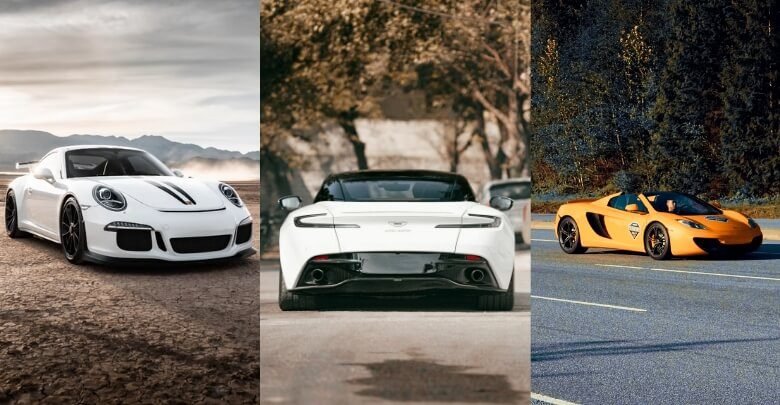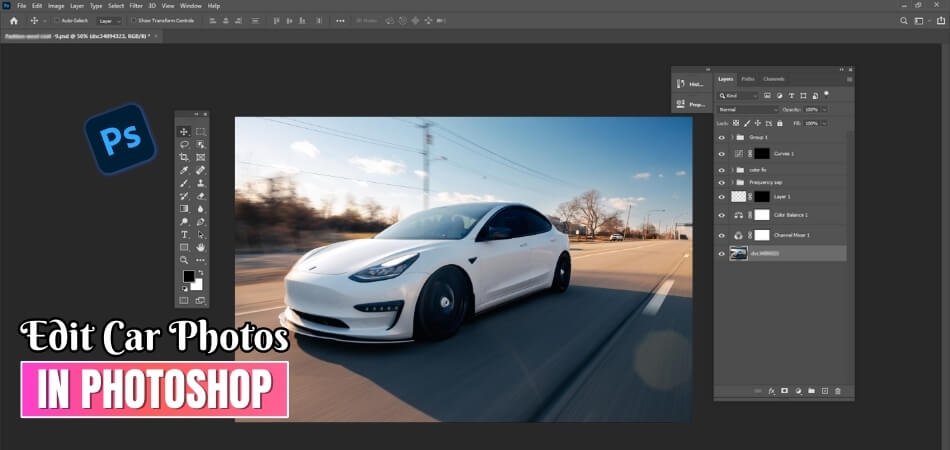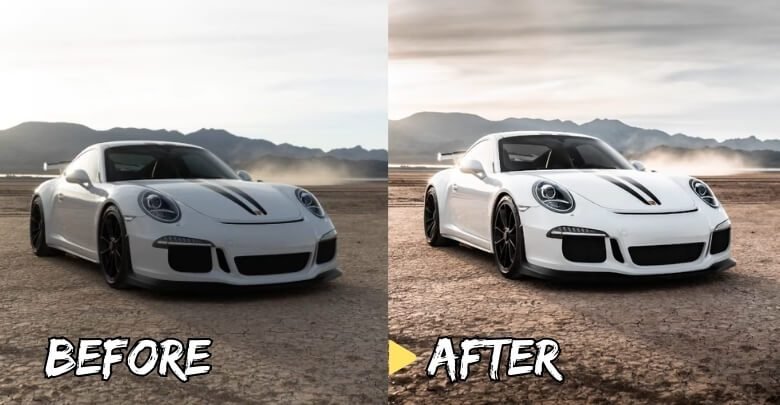Car photography goes beyond just capturing the design and aesthetics. The main goal is to show the car in the best light possible. It will be helpful to make the vehicle stand out in the marketplace. When it comes to advertising, listings online, or car magazines, car editing is essential. You will get to know here in detail how to edit car photos in Photoshop.
You can simply start by uploading the car image to Photoshop. After that, adjust the levels and colors so that the image looks sharp and balanced. Make sure to use the healing brush tool to correct any surface imperfections. More details about it will be shared inside the article. Let’s slide down to the main details.
Why Car Photos Need to Be Edited?
You can edit car photos for capturing the viewer’s attention in a saturated market. Clear images will make the vehicle best features more visible. This visual appeal is important for dealerships and private sellers alike. A professional automotive photo editing service can refine these images to professional quality.

Such improvements are important for online listings and advertisements. Well-edited photos will convey the care a seller has for their vehicle. They will also help establish a sense of trust and quality in potential buyers. Overall, these images can significantly influence purchasing decisions.
Do Car Photos Have a Variety of Editing Techniques?
Yes, car photos can be made better using a variety of editing techniques. Each method brings out new detail of vehicle photography. Here are some popular techniques for improving these images:

Basic Adjustments
A basic adjustment forms the basis of an image’s quality. In this method, you can adjust exposure and contrast to make the vehicle pop against any background. Besides, color correction will ensure the paint looks true to life. The leather seats can be fine-tuned by tweaking sharpness to bring out their texture.
Retouching Techniques
Retouching is another key technique in editing car photos. Remove unwanted reflections and bring the focus back into car. If you are not so familiar with these kind of tasks, then you can always take help of professional automotive photo editor. They will help to make a significant impact on the overall image.
Creative Effects
Car photography can be enhanced with creative effects. You can also add a vignette that draws attention directly to the vehicle. The overlaying of textures can give the image a rugged or sleek look based on the desired effect. This techniques can truly capture and convey the vehicle’s beauty and essence.
How to Edit Car Photos in Photoshop?
Photoshop can transform a standard image into an eye-catching piece of art. Beginners can also optimize their vehicle photography with the right tools and techniques. Follow the instructions shared below to learn how to edit car photos in Photoshop effectively:

Step 1: Import Your Image
Start by opening Photoshop and importing the car photo you wish to edit. Use the ‘File’ menu to select ‘Open’ and select the path to your image. This step prepares you for all subsequent editing actions.
Step 2: Adjust Levels and Colors
The next step is to correct the brightness and contrast of your image. Go to ‘Image’, select ‘Adjustments’, and then ‘Levels’. Fine-tuning these settings can dramatically improve the photo’s visual impact.
Step 3: Clean Up Imperfections
The Healing Brush tool can be used to remove scratches or blemishes on the car’s surface. Select the Healing Brush from the toolbar, choose an appropriate brush size, and carefully paint over the imperfections. This will help the car to look pristine.
Step 4: Refine Sharpness
The sharper your image, the more details you will see. Go to ‘Filter’, choose ‘Sharpen’, and then select ‘Unsharp Mask’. Adjust the settings to get a crisp and clear output without overdoing it.
Step 5: Apply Color Correction
Color correction is important for making the car’s paint look vibrant and true to its original color. Simply go to ‘Image’, click on ‘Adjustments’, and then ‘Hue/Saturation’. Tweak these to bring out the vehicle’s color without making it look unnatural.
Step 6: Add Creative Effects
For a final touch, add creative effects like vignettes or selective coloring. These effects can be accessed through the ‘Effects’ panel. Experiment with different effects to give your photo a unique aesthetic or highlight specific features of the car.
Who Benefits from Car Photo Editing?
There are several industries that benefit from car photo editing. It also serves a practical purpose as well as adding visual appeal. A high-quality image is essential to effectively showcasing vehicle features in marketing and sales. Professional car photo editing benefits the following people most:

Automobile Dealerships
Dealerships rely heavily on car photo editing to attract buyers. The right images help them stand out in a competitive online marketplace. Clear photos can significantly increase customer interest and inquiries. Overall, better visuals lead to higher dealership sales figures.
Auto Manufacturers
Manufacturers use edited images for promotional materials and brochures. High-quality photos accurately represent vehicle design and features. Editing car photos in Photoshop helps to maintain brand consistency across all marketing platforms. This practice ensures that the cars look their best in all consumer-facing content.
Automotive Magazines
Magazines featuring cars need high-quality images to capture their readers. Photo editing contributes to the visual storytelling in articles and reviews. Clear images complement editorial content, and make it more engaging.
Online Car Sellers
Individuals selling cars online also benefit from edited photos. High-quality images can make listings more appealing and trustworthy. Sellers can highlight the car’s best features and condition more effectively. This will result in quicker sales and higher offers from buyers.
Marketing Professionals
Marketing experts use edited photos to create impactful campaigns. They need compelling visuals for online ads, billboards, and digital content. Well-edited images help them to convey the message and attract potential customers.
Auto sales and marketing often begin with a visual impression. So, car photo editing plays an essential role here. You can use professional editing service to create the perfect first impression. It will result in tangible benefits for all stakeholders.
Tips for Improving Car Photo Editing In Photoshop
Car photo editing in Photoshop involves attention to detail and creativity. The use of effective editing will enhance a vehicle’s aesthetics as well as its market appeal. The following tips will help you improve your car photo editing Skills.
- Use Proper Lighting: Good lighting is essential for high-quality car images. It reduces the need for extensive post-editing and enhances natural details.
- Focus on Color Accuracy: You need to ensure the car color is represented accurately. Adjust the saturation and vibrancy to reflect the true hues of the vehicle.
- Remove Distractions: Clean up the background and remove distracting elements. This will keep the focus on the car, and make it the centerpiece of your photo.
- Enhance Details Sharply: Pay attention to sharpening the details like the headlights and grill. However, avoid over-sharpening as it can make the image look unnatural.
- Experiment with Angles: Try different angles to find the most flattering perspective for the car. Unique angles can highlight specific features and create visual interest.
Frequently Asked Questions (FAQs)
Photoshop is considered one of the best tool when it comes to car photo editing. They are very useful when you are using them for marketing purpose. Some of the common questions related to this topic is answered below. Let’s take a closer look.
Can Photoshop Auto Edit Photos?
No, Photoshop does not have a feature for fully automated editing. However, it offers various tools and presets that can simplify the editing process. You should look for an AI-based editor for auto car photo editing.
Does Photoshop Have Auto Color Correction?
Yes, Photoshop offers an auto Color Correction feature. It can quickly adjust the color balance and tones in an image. This features can be beneficial when you wish to edit your car photos in a pretty short time.
What Are Some Common Mistakes to Avoid when Editing Car Photos in Photoshop?
Some common mistakes to avoid when editing car photos in Photoshop include over-editing. If you use too many filters or effects, it is not going to be a good choice. Besides, you should also avoid common mistakes like not paying attention to details.
Can I Change the Background of a Car Photo in Photoshop?
Yes, you can change the background of a car photo in Photoshop. You need to use the selection tools like the Quick Selection tool or the Pen tool to select the car. After that, replace it with a new background layer.
Is It Necessary to Shoot in RAW Format for Car Photo Editing in Photoshop?
RAW format for car photo preserves more image data and can be edited using Photoshop. It will allow more extensive adjustments without compromising image quality. However, JPEG images can also be edited in Photoshop effectively.
Final Verdict
You already know how to edit car photos in Photoshop. If you have good skills in Photoshop editing, than you can create some great automotive photos. Photoshop is an all-in-one tool for your editing need. If you are not so good in this work, you can always take professional automotive editors.
They will enhance every detail of your car photos and make them appear appealing. You can share with them referral images or guideline and ensure top quality editing for your need. Let us know what else you want us to cover. Keep coming back for more updates shortly.